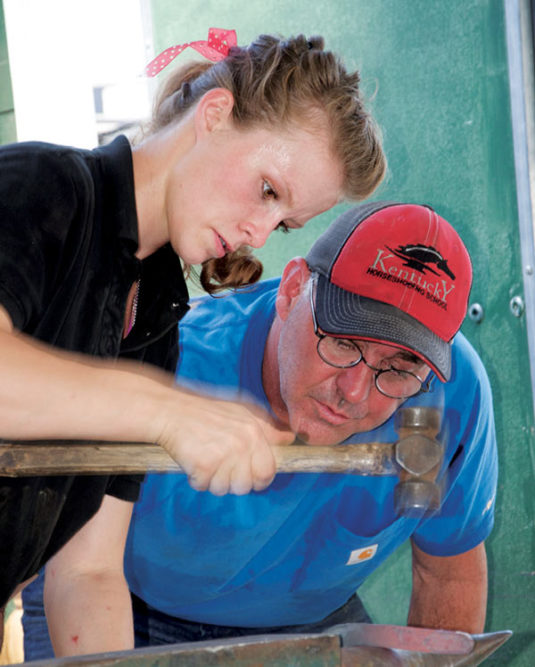Pictured Above: A good apprentice has gained a standard of proficiency in the trade's fundamentals.
It’s important for the farrier school graduate and the mentor to understand the definition of the word “apprentice” before either individual enters into a working relationship.
Many farriers just want an employee, “another tool in their box,” so to speak — someone to clinch and finish or to trim 30 or 40 broodmares — and may not spend all day with the employee or work with them after-hours in the shop. If you want an employee, that’s easy. There are a lot of students who just need to make money and are happy where they are. However, hiring an employee is different than taking on an apprentice.
Webster’s Dictionary defines an apprentice as “one who is learning by practical experience under skilled workers in a trade, art or calling.”
By this definition, an apprenticeship is a mutually beneficial relationship — a supervised educational time for the student with accountability from both parties.
The mentor has a responsibility to guide and teach, preferably with an end goal in mind — such as American Farrier’s Association certification — and the apprentice has the responsibility to complete duties in a timely manner and continue to progress.
It's important that the student doesn't leave the apprenticeship early.
The education and training of farriers should incorporate a school and an apprenticeship.
Personal integrity is often more valued by mentors than other attributes.
The apprentice needs to understand that it’s a low-paying job, but there is an educational component to it that makes the learning process more efficient and comprehensive than learning by trial and error. Trial and error has massive implications on the welfare of the horse, reputation of the individual and the trade as a whole. So, an apprenticeship has a different degree of accountability from both parties than does an employer-employee relationship.
Essentially, the apprentice will cost the mentor money at the beginning as the mentor invests his time. In turn, the apprentice will eventually earn the mentor money, or “payback,” as their skills and knowledge develop under the mentor’s tutelage. It is this synthesis of working and learning that makes an apprenticeship a mutually-beneficial relationship. The lessons learned from the mentor should complete the learning experience by helping the apprentice gain the mastery of farrier skill in the most efficient manner and ultimately prevent issues that could result in harm to the horse by learning in an unsupervised environment.
Primary Farrier Education
Unlike some other professions, the ability to successfully maintain and provide protection for hoof capsules on a variety of equine ages, breeds, disciplines and environments takes years to master. Vocational education and training is the most efficient way of gaining the skills needed for success.
According to Chris Barnes at eLearning.com, “Education and training aims to equip people with knowledge, know-how, skills and competences required in particular occupations.” That’s why a reputable, curriculum-based school, followed by an apprenticeship with a qualified mentor, is critical for success.
There are subtle, yet important differences between education and training. Both are important aspects of learning correct farrier principles. Education is about learning the theory of something. A sound base in theory affords the student the ability to evolve and progress in their skills over time, rather than just get better and faster at the same skills. Training should be done after acquiring an appropriate theory base. Training is repetitive in nature that develops hand-eye coordination and the muscle memory needed for practical skills execution. A farrier school curriculum employs both education and training methods; an apprenticeship is much stronger in the training aspect.
My experiences have molded my opinion that learning farriery happens by two methods. The first is monkey-see monkey-do — watching and copying someone execute the trade. Although some can learn to “shoe horses” this way, especially those with natural skills, the ability to constantly evolve is hampered by the lack of a theoretical foundation.
The second method involves a formal educational curriculum combined with supervised practice at a reputable school. It is with this knowledge of cause and effect that the young farrier can truly evolve, improve and change throughout their career.
Ideally, the education and training of farriers should incorporate a school and an apprenticeship. The job of a school is not to make finished farriers who are ready to work for the general public. Instead, it is the job of a school to provide primary education in the essential elements of correct farriery. Realistically, a school should only build competent apprentices, rather than finished farriers. A hands-on formal apprenticeship is a critical component for the student to develop into a successful professional farrier.
In 2010, the Kentucky Horseshoeing School (KHS) started a 9-month program in which an apprenticeship is highly encouraged after graduation. By earning a diploma, the student has demonstrated that a standard of proficiency of the theory and practicum in the basic elements of the trade has been gained. In other words, they are ready to fulfill the duties of serving an apprenticeship with a qualified professional farrier. The KHS curriculum is divided into two primary modules — theory and practical skills.
The theory curriculum has been designed to teach students the underpinning foundation elements of the trade such as anatomy, physiology, biomechanics, conformation, locomotion, lameness/pathology, as well as business studies. It also includes a section that we call “theory of farrier practice,” which involves lectures and demonstrations on metallurgy, the methodology of foot preparation, shoemaking, shoe fitting, shoe application, welding, fullering, punching nail holes and clipping. It is only through an understanding of why things are done when one can truly progress and improve oneself as a person and a professional.
The practical module focuses on becoming proficient in the underpinning foundation of the practical skills of shoeing horses through an organized progression of skill proficiency tests that include trimming feet and individual elements of forge work that were taught in the previous term.
So why invest time and money in farrier school when there are people willing to take on an apprentice with no skills? The individual needs of every mentor vary. What doesn’t change is that competent farriers hire apprentices to:
1
Help the mentor manage the workload and increase revenue.
2
Improve the trade through continuing education of skilled apprentices.
KHS believes it creates a stronger industry through better education. It teaches students that an apprentice must:
- Be on time.
- Set up and breakdown a farrier rig.
- Keep the rig stocked with inventory.
- Keep the shoeing area clean.
- Pull a set of shoes, and clinch and finish in a reasonable time.
- Trim barefoot stock.
- Drill and tap shoes, box and safe shoes and apply pads.
- Keep horses calm when working.
- Avoid talking to owners and managers unless it’s approved.
- Help with other third-hand duties, such as gluing.
It’s my job to help develop the primary skills needed to be a successful apprentice. In addition, it’s my job to teach steps, systems and methodology for things that a busy mentor does not have the time or inclination for, such as positions under the horse, knife sharpening, hammer control, fire control, basic shoe making, among other higher order skills. Successful completion of these goals gives the best chance for a successful career and minimizes the risk to the welfare of the horse and gains both owner and veterinary confidence in the individual and trade as a whole.
A Good Apprentice
There are a number of attributes that helps make a good apprentice. Among them are mastering the fundamentals of the trade, personal integrity, horsemanship and a desire to learn.
Master the fundamentals. A good apprentice has gained a standard of proficiency in the fundamentals of the trade. That’s why it’s important to go to a reputable farrier school. Students can learn much more when they understand farrier theory such as the anatomy and physiology of the distal limb, understand the relationship of conformation to movement and foot deformation; and understand the concepts of shoes and the biomechanics of how to trim feet.
Personal integrity. Mentors can deal with students who are not very handy, as long as they possess a certain level of competence — hand-eye coordination and skill. That’s my job to get them up to speed. When I’ve talked to many mentors over the years, they prefer a high-quality, honest person over the best student who made the prettiest shoes, but did not have personal integrity. An apprentice needs to value their commitment to the mentor and respect the mentor’s commitment to their education.
Horsemanship. It’s important for a student to have a degree of horsemanship, so that he or she can get underneath the horses, keep them comfortable, and not get them juiced up. Mentors have spent a lot of time getting these horses used to being shod. The last thing they need is a nervous apprentice jabbing them with a rasp because they haven’t learned how to listen to the horse when it’s telling them that it’s uncomfortable. It’s my job as a primary farrier instructor to develop these skills in a student.
Desire to learn. It’s important to have an earnest hunger to learn, be open-minded and willing to work hard. On the first day for every class, KHS tells students, “You are starting on a lifetime of learning.” There might be times during the busy season when you have to work 7 days a week. The apprentice needs to suck it up and do it. In turn, it is the mentor’s responsibility to say, “OK, now we’re done with this show scene. Let’s all take some time and go fishing.”
Just like dealing with horses, there needs to be mutual respect and commitment from both parties.









Post a comment
Report Abusive Comment